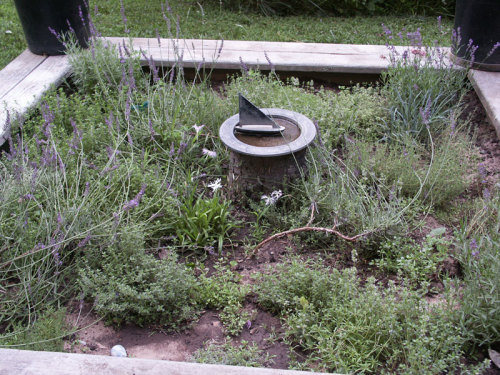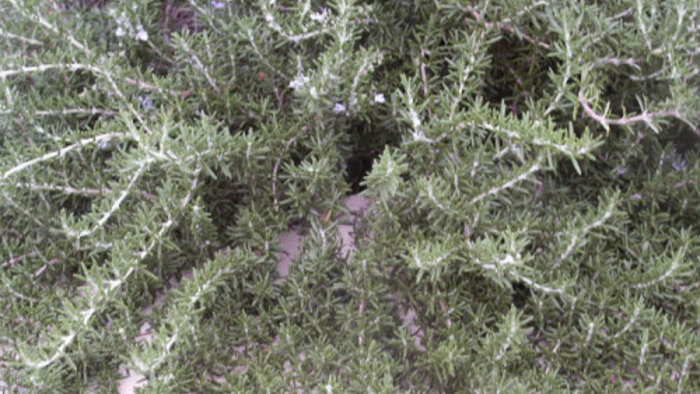
Thyme is an herb of Mediterranean origin, and is one we can consider a woody robust herb. It is useful in all kinds of dishes from appetizers to desserts and goes well with seasonal winter produce as well as grains, beans, nuts, as well as meat, fish and fowl. As the aroma intimates, it is a sweetish though pungent herb when fresh—a combination to scent and savor. The Classical Greeks, who were conventional in the culinary use of many common herbs, embraced thyme enthusiastically. Perhaps this is because they discovered the appeal thyme had for bees, and tasted the honey which was the fruit of thyme’s perfume and the bees’ chemistry. Decidedly a taste of the renowned Mount Hymettus honey is a sensual recognition of the beauty and power of thyme.
Greeks did not limit their use of thyme to home and restaurant kitchens; they also made liqueurs with it, burned it in their temples, and bathed in it. The root of thyme’s name is definitely Greek, although whether it derives from thuo, “to fumigate,” “to perfume,” or from thumus, “courage, without fear of death” is uncertain.
Thyme in the kitchen
In uses closer to the cook, the French, Italians and Spanish grazed sheep and goats on thyme for the flavor it gave to their meat. The herb was used in many rich dishes, as it was believed to alleviate the sufferings of gout. Thyme will add a soft plummy fragrance and subtle taste compounded of mint, bay, and marjoram to almost all cooked foods. It is good with cereal grains, especially rice and wheat; all meats; eggs; most vegetables, especially potatoes, carrots, squash, onions, and tomatoes; and it makes a superb marriage with shellfish and fish. Although it loses some of its fragrant quality in drying, which emphasizes an earthy aroma and pungent flavor, thyme enriches the simplest soup or stew and gives a delectable accent to fruits and salads. It is indispensable in bouquets garnis for making stock, particularly chicken and lamb stocks. A good part of our kitchen wealth is concentrated in freshly harvested bundles of thyme.
Selecting a variety to grow
Thyme germinates easily from seed, though it is chancy to grow it this way because seed tends to be genetically unstable, and most seed sold is a mixture of varieties. For culinary use, many kinds of Thymus vulgaris are available; French, English, and German thyme are common names. Their aromatic properties are similar, the distinctions being made in the width of their leaves. To decide which thymes to grow, choose a nursery or herb grower that offers named varieties, such as “Broad-leaf English,” or “Narrow-leaf French.” Probably my favorite culinary thymes are French and ‘Provençal’. Sniff your way through the thymes, taking a break now and then, and select the one or ones that appeal to you.
There are some interesting scented varieties, the lemon thymes, caraway thyme, and even orange thyme. These should be used fresh, with little or no cooking, unless used in baked goods which seem to capture the essence of the herb in the surrounding dough or batter. They are excellent marinating herbs. There are beautiful variegated thymes, such as Silver Thyme (T. argenteus), which tend to have a milder flavor and aroma, which is lost in cooking.
The species of creeping thymes, Thymus praecox spp., are beautiful ground covers if there is space for them in the garden. Although they are not really culinary herbs, we grow some varieties to provide magic carpets for the bees. All thymes grow best in sandy soil, as their fine root structures are unable to find enough nutrients in heavy soil. They are hardy but will not live through very cold winters without mulching.
Pruning, harvesting, and drying, thyme
 |
|
| Greek salad with thyme vinaigrette will please your palate. Get the recipe. |
Thymes should be cut heavily several times a year, especially where summers are hot and humid. Prune thyme first in early spring or late winter, when temperatures begin to warm. Then again when flowers form, and again in mid-summer, or forty-five to sixty days after flowering. The final harvest/pruning should take place about sixty days before the first frost is expected; this may coincide with mid-summer cutting in some climates.
Pruning serves three purposes: it prevents plants from becoming woody, a condition that shortens their lives; it lessens the chances of severe fungus disease, which is more likely to occur in thick stands of matted thyme; and it provides the cook with dried thyme. Cut about three or four inches of the stems and hang them in small bunches or spread them on screens to dry.
In the house, thyme does not require special care if it is transplanted to a wide pot with well-drained, sandy soil and given plenty of sun.
 More robust herbs … More robust herbs …
• Using Sage in Warming Winter Dishes |
Fine Gardening Recommended Products

Berry & Bird Rabbiting Spade, Trenching Shovel
Fine Gardening receives a commission for items purchased through links on this site, including Amazon Associates and other affiliate advertising programs.

Chapin International 10509 Upside-Down Trigger Sprayer
Fine Gardening receives a commission for items purchased through links on this site, including Amazon Associates and other affiliate advertising programs.

Razor-Back Potato/Refuse Hook
Fine Gardening receives a commission for items purchased through links on this site, including Amazon Associates and other affiliate advertising programs.



















Comments
Log in or create an account to post a comment.
Sign up Log in